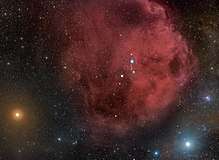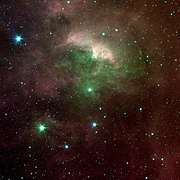HD 34989
HD 34989 is a blue-white star in the main sequence, of apparent magnitude 5.80,[2] in the constellation of Orion. It is 1700 light-years from the solar system.
| Observation data Epoch J2000.0 Equinox J2000.0 | |
|---|---|
| Constellation | Orion |
| Right ascension | 05h 21m 43.5619s[1] |
| Declination | +08° 25′ 42.841″[1] |
| Apparent magnitude (V) | 5.80[2] |
| Characteristics | |
| Spectral type | B1V[3] |
| U−B color index | -0.88 [2] |
| B−V color index | -0.13[2] |
| Astrometry | |
| Radial velocity (Rv) | 25.30±3.5[4] km/s |
| Proper motion (μ) | RA: −0.438±0.227[1] mas/yr Dec.: −4.493±0.184[1] mas/yr |
| Parallax (π) | 1.8706 ± 0.1413[1] mas |
| Distance | 1,700 ± 100 ly (530 ± 40 pc) |
| Absolute magnitude (MV) | -2.36[5] |
| Details | |
| Mass | 12.1±0.1[6] M☉ |
| Luminosity | 1,508[5] L☉ |
| Surface gravity (log g) | 4.194±0.044[7] cgs |
| Temperature | 24,838±450[7] K |
| Metallicity [Fe/H] | -0.43[8] dex |
| Age | 8.0±2.0[6] Myr |
| Other designations | |
HIP 25041, HD 34989, PMC 90-93 1242, uvby98 100034989, AG +08 591, HIC 25041, PPM 148818, VDB 38, ALS 8286, HR 1763, ROT 774, WH 21, BD +08 933, IRAS 05190+0822, SAO 112667, YZ 8 2140, FK5 2401, JP11 1038, [KSP2003] G194.6241-15.6072, GC 6574, LS VI +08 1, TD1 4461, [KSP2003] J052143.58+082543.0, GCRV 3206, 2MASS J05214355+0825425, TYC 700-1015-1, [M26] 1, MCW 299, UBV 5096, [SC93b] 146, GSC 00700-01015, N30 1147, UBV M 10870 | |
| Database references | |
| SIMBAD | data |
Observation
The star is in the northern celestial hemisphere, but close to the celestial equator; this means that it can be observed from all the inhabited regions of the Earth without difficulty and that it is not visible only in the innermost areas of Antarctica. It appears as circumpolar only far beyond the Arctic polar circle. Its brightness puts it at the limit of visibility to the naked eye, so to be observed without the aid of devices requires a clear, and preferably moonless, sky.
The best period for observation in the evening sky is between late October and April from both hemispheres; in February (as at J2000) it is anti-posed from the sun. In July and August its direction is close to that of the sun, therefore coinciding with most hours of daylight.
Physical characteristics
It is a blue-white star of the main sequence, having an absolute magnitude of -0.99 and its positive radial velocity[4] indicates that the star is moving away from the solar system.
The star appears wrapped in an extensive nebulosity that partly shines by reflection and partly by emission. The reflection nebula is listed as GN 05.19.0[9] and the HII region is called Sh2-263. HD 34989 is the ionizing source of this HII-region. In observations with carbon monoxide this corresponds to a circular hole.[10]
The star has a size of about 0.118 ± 0.026 milliarcseconds, based on SED fitting.[11]

 HD 34989 in the center, shown at infrared wavelengths with the Spitzer Space Telescope.
HD 34989 in the center, shown at infrared wavelengths with the Spitzer Space Telescope.
References
- Gaia Collaboration (2018-08-01). "Gaia Data Release 2 - Summary of the contents and survey properties". Astronomy & Astrophysics. 616: A1. arXiv:1804.09365. doi:10.1051/0004-6361/201833051. ISSN 0004-6361.
- Ducati, J. R. (2002). "VizieR Online Data Catalog: Catalogue of Stellar Photometry in Johnson's 11-color system". YCat. Bibcode:2002yCat.2237....0D.
- Sharpless, Stewart (September 1952). "A Study of the Orion Aggregate of Early-Type Stars". Astrophysical Journal. 116: 251. Bibcode:1952ApJ...116..251S. doi:10.1086/145610. ISSN 0004-637X.
- Gontcharov, G. A. (November 2006). "Pulkovo Compilation of Radial Velocities for 35 495 Hipparcos stars in a common system". AstL. 32 (11): 759–771. arXiv:1606.08053. Bibcode:2006AstL...32..759G. doi:10.1134/S1063773706110065. ISSN 1063-7737.
- Anderson, E.; Francis, Ch. (2012). "XHIP: An extended hipparcos compilation". Astronomy Letters. 38 (5): 331. arXiv:1108.4971. Bibcode:2012AstL...38..331A. doi:10.1134/S1063773712050015.
- Tetzlaff, N.; Neuhäuser, R.; Hohle, M. M. (2011-01-01). "A catalogue of young runaway Hipparcos stars within 3 kpc from the Sun". Monthly Notices of the Royal Astronomical Society. 410 (1): 190–200. arXiv:1007.4883. Bibcode:2011MNRAS.410..190T. doi:10.1111/j.1365-2966.2010.17434.x. ISSN 0035-8711.
- Huang, Wenjin; Gies, D. R.; McSwain, M. V. (October 2010). "A Stellar Rotation Census of B Stars: From ZAMS to TAMS". Astrophysical Journal. 722 (1): 605–619. arXiv:1008.1761. Bibcode:2010ApJ...722..605H. doi:10.1088/0004-637X/722/1/605. ISSN 0004-637X.
- Soubiran, Caroline; Le Campion, Jean-François; Brouillet, Nathalie; Chemin, Laurent (2016). "The PASTEL catalogue: 2016 version". Astronomy and Astrophysics. 591: A118. arXiv:1605.07384. Bibcode:2016A&A...591A.118S. doi:10.1051/0004-6361/201628497.
- Magakian, T. Yu (February 2003). "Merged catalogue of reflection nebulae". A&A. 399: 141–145. Bibcode:2003A&A...399..141M. doi:10.1051/0004-6361:20021743. ISSN 0004-6361.
- Lang, W. J.; Masheder, M. R. W.; Dame, T. M.; Thaddeus, P. (May 2000). "The lambda -Orionis Ring in CO". A&A. 357: 1001–1012. Bibcode:2000A&A...357.1001L. ISSN 0004-6361.
- Swihart, Samuel J.; Garcia, E. Victor; Stassun, Keivan G.; Belle, Gerard van; Mutterspaugh, Matthew W.; Elias, Nicholas (December 2016). "A Catalog of Calibrator Stars for Next-Generation Optical Interferometers". The Astronomical Journal. 153 (1): 16. arXiv:1610.04600. doi:10.3847/1538-3881/153/1/16. ISSN 1538-3881.